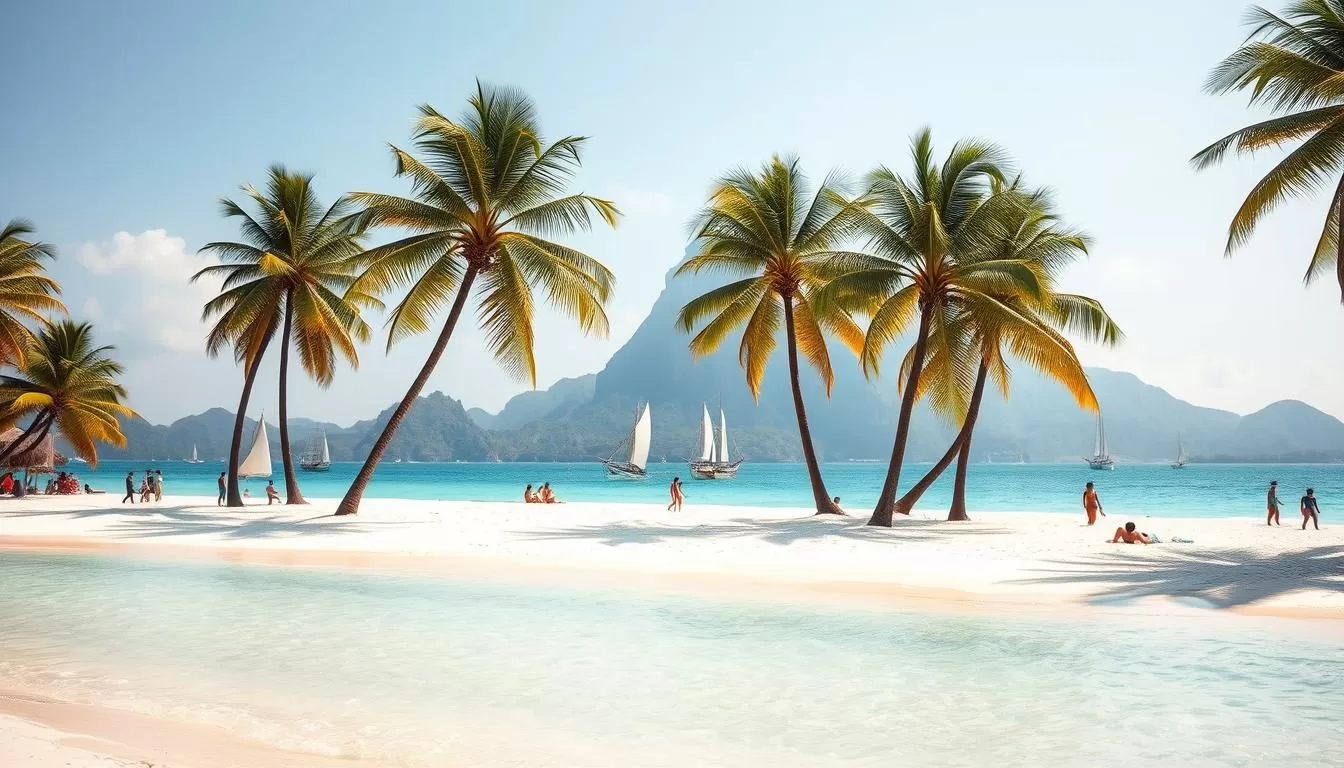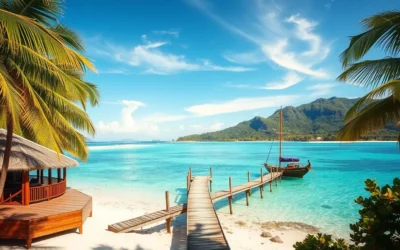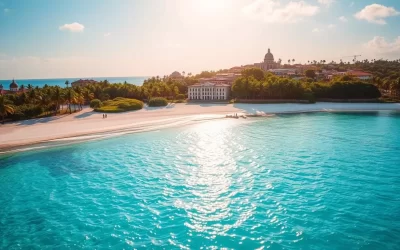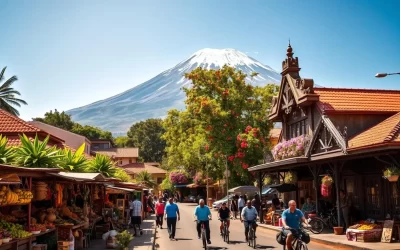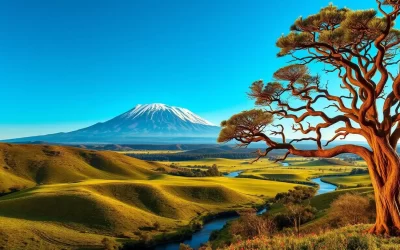Imagine an island getaway with crystal-clear water and exciting wildlife experiences. The East African coastline is home to a tropical paradise that will captivate your senses. With a rich history as the last slave market in the world, Zanzibar City offers a unique blend of cultural influences.
As you explore this enchanting island, you’ll discover pristine beaches, a fascinating history, and a blend of Arabic, Indian, and Swahili cultures. The warm hospitality of the locals will make your travel experience truly unforgettable, allowing you to live a relaxed life for some time.
Discovering the Magic of Zanzibar
Zanzibar, known as the “Spice Island,” is a treasure trove of history, culture, and natural beauty waiting to be explored. As you delve into the island’s rich history and vibrant culture, you’ll uncover the secrets that have made Zanzibar a coveted travel destination for centuries.
A Brief History of the Spice Island
The history of Zanzibar is as fascinating as it is complex. Once a major maritime hub, the island has been influenced by various cultures, including Arabian, Indian, European, and African traditions. This diverse heritage is reflected in the island’s architecture, cuisine, and way of life.  The strategic location of Zanzibar in the Indian Ocean made it a crucial stop on ancient trade routes, attracting merchants, explorers, and settlers from around the world.
The strategic location of Zanzibar in the Indian Ocean made it a crucial stop on ancient trade routes, attracting merchants, explorers, and settlers from around the world.
As the “Spice Island,” Zanzibar was once the world’s largest producer of cloves and remains an important source of spices like cinnamon, nutmeg, and black pepper. The spice trade has not only shaped the island’s economy but also influenced its cuisine, making it a unique culinary experience. Understanding Zanzibar’s complex history, including its role in the slave trade and as a sultanate, provides important context for appreciating the cultural sites and experiences you’ll encounter during your visit.
When to Visit Zanzibar
Planning your trip to Zanzibar requires considering the best time to visit. The island experiences a tropical climate, with two main dry seasons: June to October and December to February. These periods offer pleasant temperatures, minimal rainfall, and optimal conditions for beach activities and sightseeing, making them the ideal time to explore the island.
During the dry seasons, you can enjoy a wide range of activities, from relaxing on the beautiful beaches to exploring the historic Stone Town. The comfortable weather conditions also make it an ideal time for outdoor adventures, such as snorkeling, diving, and spice tours. Whether you’re looking to unwind or explore, Zanzibar is a destination that promises an unforgettable experience in the heart of the Indian Ocean.
Exploring Stone Town: A UNESCO World Heritage Site
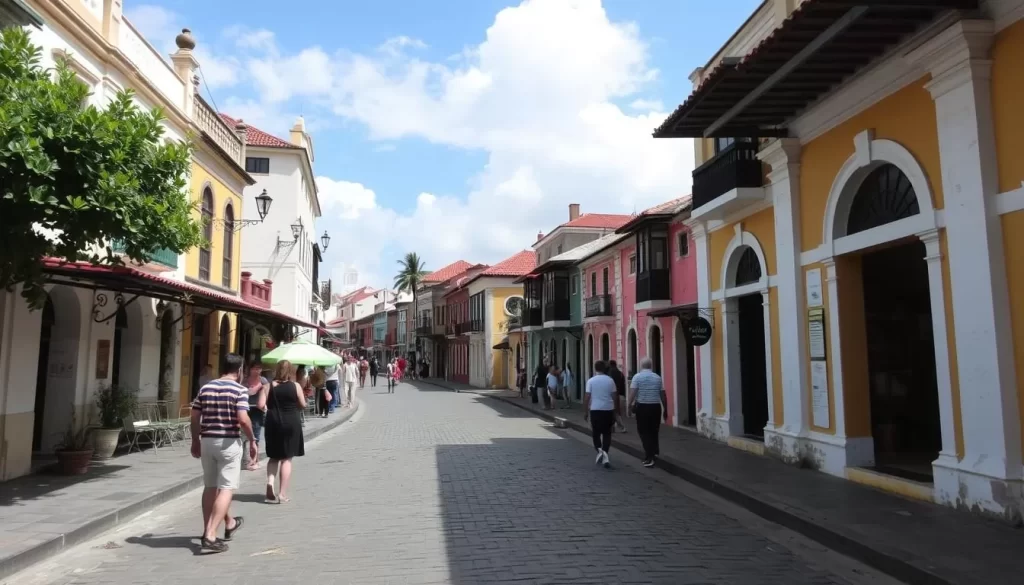
With its narrow streets and ancient stone buildings, Stone Town is a fascinating blend of African, Arab, and European influences. As the historic center of Zanzibar City, it has earned its UNESCO World Heritage status due to its exceptional preservation of Swahili coastal trading town culture.
Stone Town is best explored on foot, allowing you to absorb the rich history and cultural nuances that permeate every alleyway. Joining a guided walking tour is the best way to gain insights into the history, culture, and architecture of Stone Town and Zanzibar Island. A knowledgeable guide will lead you through the narrow streets, sharing stories that bring the town’s past to life.
Must-See Historical Landmarks
Stone Town is home to numerous historical landmarks that reflect its complex past. Must-see sights include the Old Fort of Zanzibar, House of Wonders, and the People’s Palace Museum. The Freddie Mercury Museum is another significant attraction, celebrating the life of Zanzibar’s most famous son.
Other notable landmarks include the Darajani Bazaar and Darajani Fish Market, which offer a glimpse into the daily life of Stone Town’s residents. The Old Slave Market/Anglican Cathedral and St Joseph’s Cathedral are poignant reminders of the town’s history, while the Forodhani Gardens provide a serene escape from the bustling streets.
The Famous Carved Doors of Zanzibar
One of the most distinctive architectural features in Stone Town is the famous carved doors of Zanzibar. Each intricate design tells a story about the original owner’s wealth, status, and cultural background. These doors are not just beautiful works of art but also significant historical artifacts that reflect the island’s rich cultural heritage.
The craftsmanship that goes into creating these doors is a testament to the skill and artistry of Zanzibari craftsmen. As you walk through Stone Town, you’ll notice the unique designs and motifs that adorn these doors, each one a reflection of the island’s diverse cultural influences.
Navigating Stone Town’s Winding Alleys
Navigating Stone Town’s winding alleys can be a delightful adventure, with hidden gems waiting to be discovered around every corner. As you explore the town, you’ll come across local spice shops, artisan workshops, and quiet courtyards that provide glimpses into everyday life in this living museum.
To make the most of your time in Stone Town, take your time to wander through the alleys, allowing yourself to get a little lost in the process. This is the best way to experience the authentic charm of Stone Town and uncover its many secrets.
Prison Island: Home to Giant Aldabra Tortoises
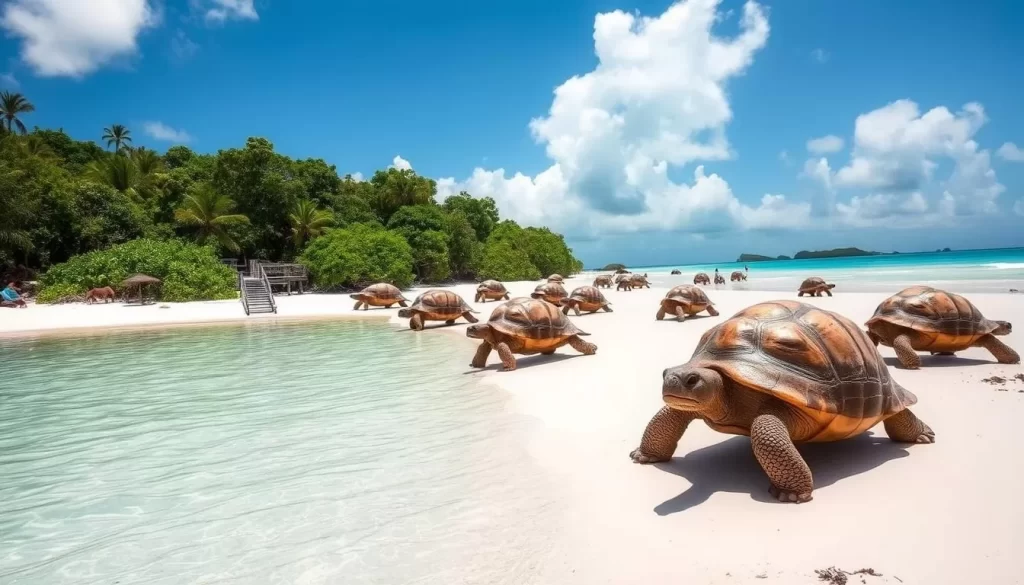
A short boat ride from Stone Town, Prison Island is an intriguing island that showcases Zanzibar’s complex past and its conservation efforts. This small island, also known as Changuu Island, has a rich history that dates back to the slave trading era.
The History Behind Prison Island
Prison Island formed a significant part of Zanzibar’s slave history, serving as a holding place for slaves before they were sent to their new destinations. Although it wasn’t a traditional prison, the island was used by slave traders for this purpose. In the 1860s, it was utilized as a prison for rebellious slaves. Later, in 1893, the British First Minister of Zanzibar purchased the island and built a prison complex, which, however, was never used as intended. Instead, it briefly served as a quarantine station for people with yellow fever.
The island’s history is a complex mix of slavery, coral mining, and eventually, conservation. Today, it is renowned for its population of giant Aldabra tortoises, some of which are over a century old.
Meeting the Century-Old Tortoises
The giant Aldabra tortoises are the main attraction on Prison Island. These magnificent creatures were originally a gift from the British governor of the Seychelles in 1919, starting with just four tortoises. Thanks to conservation efforts, their numbers have significantly increased, making the island a thriving sanctuary.
When visiting the tortoises, it’s essential to approach them respectfully. Avoid touching them unnecessarily, refrain from feeding them unless guided by staff, and give these gentle giants plenty of space as you observe them in their sanctuary. The oldest tortoise on the island is reportedly 196 years old, making it one of the oldest living reptiles on the planet.
The conservation of these tortoises is a testament to the island’s transformation from a place of historical sorrow to a haven for endangered species. As you explore Prison Island, you experience not only its historical significance but also the joy of witnessing these incredible creatures up close.
Zanzibar City, Tanzania: Best Things to Do – Top Picks
The best things to do in Zanzibar City, Tanzania, range from cultural immersion to thrilling outdoor escapades. Whether you’re a solo traveler, part of a family, or a couple, Zanzibar City offers a diverse array of activities that cater to your interests.
Top Cultural Experiences in Zanzibar City
Zanzibar City is a cultural hub where you can experience the rich heritage of Tanzania. You can start by attending a traditional taarab music performance, which is a unique blend of African, Arabic, and European influences. Participating in a local cooking class is another great way to immerse yourself in the culture, where you can learn to prepare authentic Swahili dishes using freshly sourced spices.
Joining a guided cultural tour is highly recommended. These tours take you beyond the typical tourist spots, allowing you to meet local artisans, visit community projects, and gain insights into daily life on the island. The Forodhani Gardens Night Market is a must-visit, where you can sample local street food specialties and mingle with locals and fellow travelers in a lively waterfront setting.

Best Day Trips from Zanzibar City
For those looking to explore beyond Zanzibar City, there are numerous day trip options that showcase the island’s diverse landscapes and attractions. A visit to the Jozani Forest is a great way to experience the natural beauty of Zanzibar, where you can spot the rare red colobus monkeys and explore the mangrove boardwalks.
You can also visit spice plantations to learn about the history and production of spices, which are a significant part of Zanzibar’s economy and culture. Additionally, day trips to pristine beaches like Nungwi and Kendwa offer perfect escapes, where you can enjoy the crystal-clear waters and powdery white sand.
When planning your day trips, it’s advisable to balance structured tours with free time to wander, as some of the most memorable experiences come from spontaneous interactions and discoveries in this culturally rich destination.
Spice Up Your Trip: Zanzibar’s Famous Spice Tours

Embark on a sensory journey through Zanzibar’s aromatic plantations and discover the island’s rich spice heritage. Zanzibar, aptly known as the “Spice Island,” is a paradise for those who love culinary adventures and exploring local cultures.
The History of Spice Trade in Zanzibar
The history of spice trade in Zanzibar dates back centuries, with the island once being a major hub for merchants from Arabia, India, and Europe. The fertile plantations of Zanzibar made it an ideal location for growing a variety of spices, including cloves, cinnamon, and cardamom. This rich history has not only shaped the economy but also influenced the local cuisine and culture.
The spice trade played a significant role in making Zanzibar wealthy, attracting maritime explorers and traders. Today, visitors can experience this legacy firsthand by visiting the spice farms and learning about the traditional methods of spice cultivation and harvesting.
What to Expect on a Spice Tour
On a spice tour, you can expect a multi-sensory experience that takes you through the lush plantations of Zanzibar. You’ll have the opportunity to see, touch, smell, and taste exotic spices like cloves, cinnamon, vanilla, and nutmeg in their natural environment. Knowledgeable guides will demonstrate traditional harvesting techniques and explain the various uses of each spice, from culinary delights to medicinal purposes.
Most tours include the chance to taste fresh tropical fruits and spices directly from the source, sample spiced tea, and purchase high-quality, freshly harvested spices to bring home as authentic souvenirs.
Best Spices to Bring Home as Souvenirs
When it comes to selecting the best spices to bring home, Zanzibar offers a variety of options. Some of the top choices include Zanzibar’s famous cloves, pure vanilla pods, fresh nutmeg with mace intact, cardamom, and unique spice blends like pilau masala. These not only capture the essence of Swahili cuisine but also make meaningful gifts for food-loving friends back home.
By bringing these spices back, you’re not only taking a piece of Zanzibar with you but also supporting local farmers and the local economy.
Beach Paradise: Zanzibar’s Most Beautiful Beaches
Zanzibar’s coastline is dotted with some of the most beautiful beaches in East Africa, each with its unique charm and character. The island’s beaches are renowned for their powdery white sands and crystal-clear waters, making them a perfect destination for those seeking a tranquil and picturesque getaway.
Nungwi Beach: Pristine Waters and Vibrant Nightlife
Nungwi Beach, located on the northern tip of Zanzibar, is a favorite among travelers. It boasts pristine turquoise waters and a vibrant atmosphere, with excellent swimming conditions regardless of the tide levels. The beach is lined with beachfront bars and restaurants, adding to its lively nightlife scene.
The beach itself is a broad, brilliant white stretch of soft sand, perfect for relaxation and sunbathing. As the day comes to a close, Nungwi’s beach becomes an ideal vantage point for witnessing Zanzibar’s legendary Indian Ocean sunsets.
Kendwa Beach: Perfect Sunset Views
Just south of Nungwi, Kendwa Beach is famous for its spectacular sunset views and monthly full moon parties. The beach offers calm waters and serene sunsets, making it an ideal spot for solo travelers and honeymooners alike. Kendwa Rocks hosts the popular Full Moon Party, while Zuri Zanzibar provides luxurious accommodations for those seeking a more indulgent experience.
Paje Beach: A Kitesurfer’s Dream
Paje Beach, on the southeast coast of Zanzibar, has become a mecca for kitesurfers thanks to its consistent trade winds, shallow lagoon, and powdery white sand. The beach attracts an international crowd of water sports enthusiasts, creating a laid-back, bohemian atmosphere. Paje is also known for its vibrant nightlife, with various bars and restaurants lining the beach.
Hidden Beach Gems Off the Tourist Trail
For travelers seeking more secluded experiences, Zanzibar has several hidden gems that are off the beaten path. Mnemba Island’s beaches, Matemwe’s authentic fishing village shores, and the pristine sands of Michamvi Peninsula offer tranquil alternatives to the more developed beach areas. These destinations provide a chance to experience the unspoiled beauty of Zanzibar’s coastline.
| Beach | Location | Main Attraction |
|---|---|---|
| Nungwi Beach | Northern Zanzibar | Vibrant Nightlife and Pristine Waters |
| Kendwa Beach | South of Nungwi | Spectacular Sunset Views and Full Moon Parties |
| Paje Beach | Southeast Coast | Kitesurfing and Laid-back Atmosphere |
| Mnemba Island | Off the Northeast Coast | Secluded Beaches and Snorkeling Opportunities |
Underwater Adventures: Snorkeling and Diving Spots
Explore the vibrant coral reefs and diverse marine life that make Zanzibar a top destination for underwater adventures. With numerous dive sites suitable for both beginners and experienced divers, Zanzibar’s underwater world is a treasure trove waiting to be discovered.
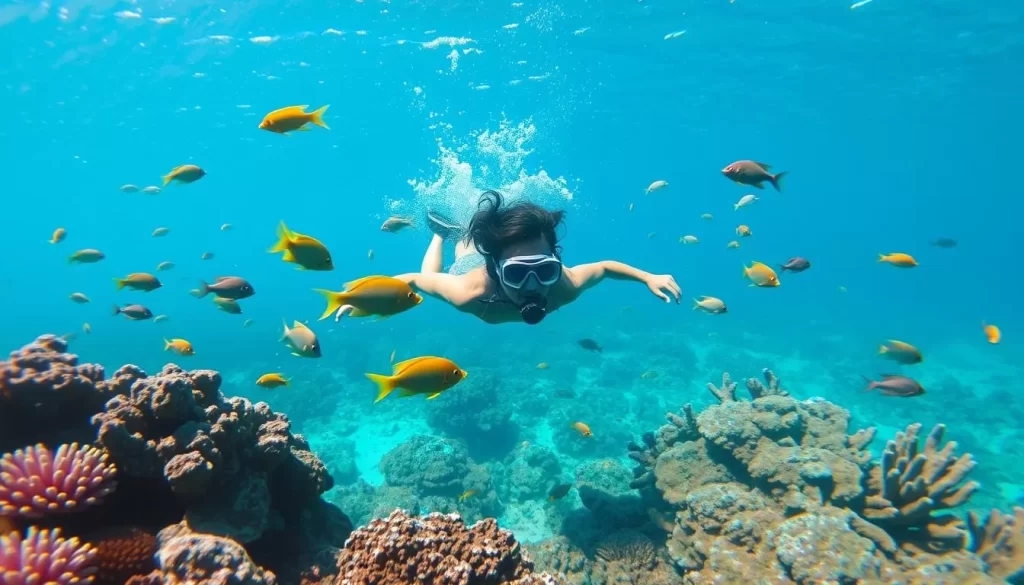
Mnemba Atoll: Zanzibar’s Premier Diving Location
For an unparalleled diving experience, head out on a dhow boat to explore the reefs in the crystal-clear shallows of Mnemba Atoll. This circular ring of islands and turquoise lagoons off Zanzibar’s northeastern shores harbors one of the Indian Ocean’s most nutrient-rich coral reefs. It’s a kaleidoscopic paradise teeming with a variety of marine life, including turquoise demoiselle fish and bulbous pufferfish.
Tumbatu Island: Coral Gardens and Marine Life
Tumbatu Island features some of the best dive sites to get your diving certification in Zanzibar. The island’s surrounding reefs are protected from strong currents, making it an ideal spot for novice divers. The coral gardens are teeming with reef fish, octopuses, and the occasional reef shark, providing an unforgettable diving experience.
Best Snorkeling Tours and Operators
When choosing snorkeling or diving operators, look for those committed to marine conservation practices, employing local guides, and maintaining small group sizes. This ensures both a quality experience and minimal impact on Zanzibar’s fragile reef ecosystems. Some popular operators offer guided tours to Mnemba Atoll and Tumbatu Island, providing a safe and enjoyable experience for all.
Zanzibar’s underwater world offers some of East Africa’s most spectacular marine environments, with vibrant coral reefs, diverse marine life, and exceptional visibility making it a paradise for snorkelers and divers alike. Whether you’re a seasoned diver or just starting out, Zanzibar has something to offer everyone.
Safari Blue: The Ultimate Ocean Adventure
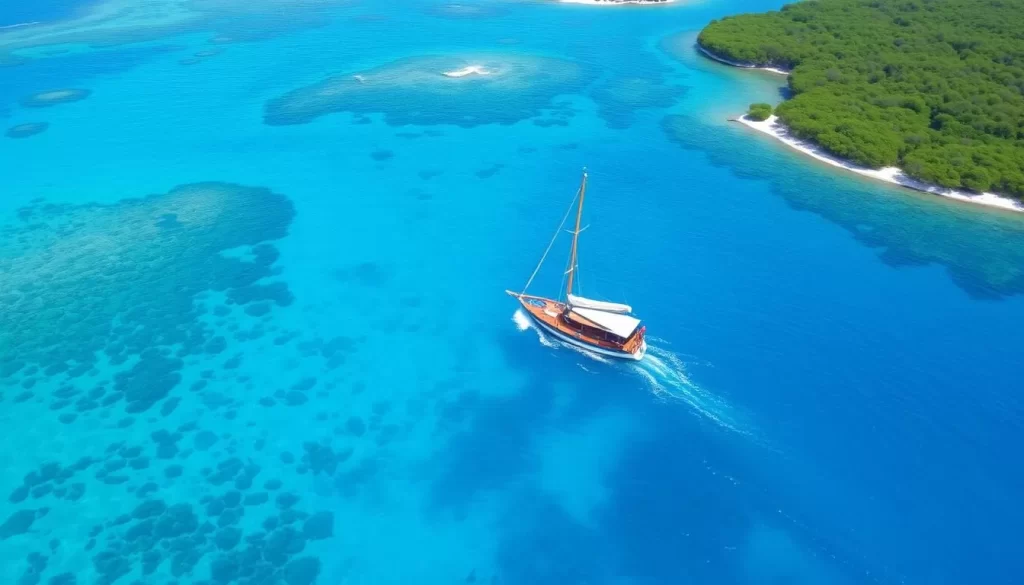
Experience the ultimate ocean adventure with Safari Blue in Zanzibar. This full-day sailing tour takes you through the breathtaking Menai Bay Conservation Area, where you can snorkel, swim, and explore the vibrant coral reefs and marine life.
What to Expect on a Safari Blue Tour
The Safari Blue tour begins with a morning pickup from your hotel and a scenic drive to the Fumba Peninsula. From there, you’ll board a traditional dhow boat and set sail for Menai Bay. During the boat ride, you’ll have the chance to admire the coastline and spot dolphins. Once you arrive, you’ll be provided with snorkeling equipment and a briefing on the marine life.
The bay is home to a diverse array of coral reefs and colorful fish, making it a paradise for snorkelers. You’ll then visit a nearby white sandbank, where you can relax and enjoy the tranquility. After snorkeling and enjoying the sandbank, you’ll be served a delicious Swahili seafood barbecue lunch on Kwale Island.
Tips for Making the Most of Your Safari Blue Experience
To maximize your Safari Blue experience, consider wearing reef-safe sunscreen and bringing a hat and sunglasses. Arriving early to secure a good spot on the boat is also advisable. Booking during weekdays can help you avoid the weekend crowds.
By following these tips, you’ll be able to fully enjoy the pristine waters and coral reefs that make Safari Blue a unique adventure. The experience includes a legendary seafood feast, featuring freshly grilled lobster, fish, and calamari, making it a truly unforgettable trip.
Jozani Forest: Encounter the Rare Red Colobus Monkeys
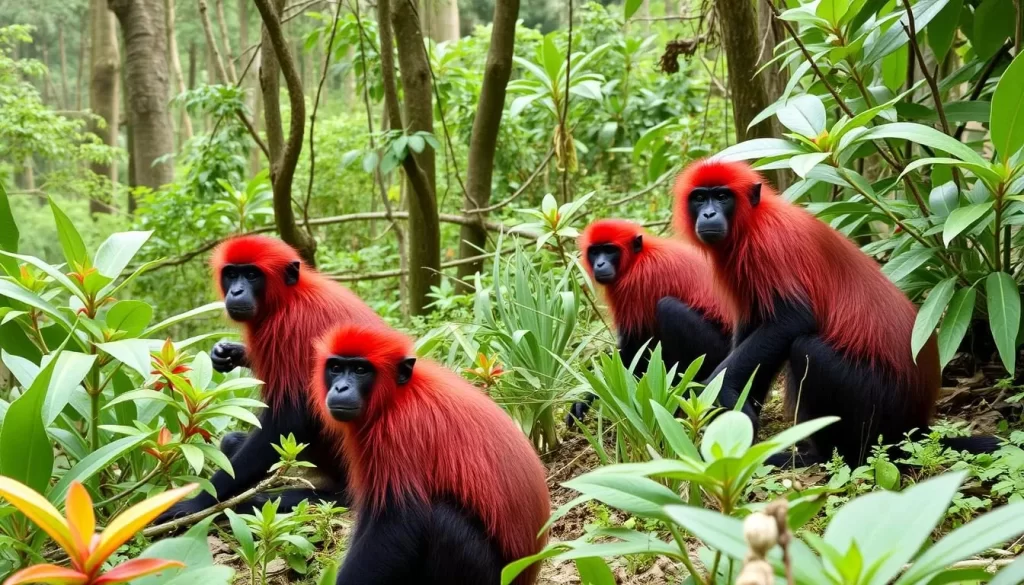
The Jozani Forest is a lush tropical ecosystem that serves as a sanctuary for the rare Zanzibar red colobus monkey. Located in the middle of Zanzibar Island, this forest is a refreshing contrast to the island’s beaches, inviting you into a world of biodiversity.
As you explore Jozani Chwaka Bay National Park, you’ll have the opportunity to see the endangered red colobus monkeys up close. These charismatic primates are known for their striking reddish-brown fur, and with a knowledgeable guide, you can learn about their habitat and the conservation efforts in place to protect them.
Wildlife Spotting in Jozani National Park
During your visit to Jozani, you can spot a variety of wildlife beyond the red colobus monkeys. Sykes’ monkeys, bush babies, and numerous bird species call this forest home. With over 50 species of butterflies, the forest is a vibrant place teeming with life. Your guide will share insights into the ecosystem and the importance of conservation in this unique environment.
For the best experience, it’s recommended to visit Jozani early in the morning or late in the afternoon when the monkeys are most active. Be sure to follow your guide’s instructions to maintain a respectful distance from the animals while still enjoying close observations of their natural behaviors.
The Mangrove Boardwalk Experience
The Mangrove Boardwalk Experience offers a unique way to explore the tidal mangrove forests within Jozani Chwaka Bay National Park. As you walk along the wooden paths, you’ll be immersed in a coastal ecosystem that serves as a crucial nursery for marine life. This experience not only provides a peaceful escape but also educates visitors on the importance of mangroves in protecting the coastline from erosion.
During your time on the Mangrove Boardwalk, take a moment to appreciate the intricate details of this ecosystem. The mangroves are home to a variety of marine life, and the wooden walkways allow you to explore this environment without disturbing it. It’s a truly enriching experience that highlights the beauty and significance of Zanzibar’s natural heritage.
Forodhani Gardens Night Market: A Culinary Adventure
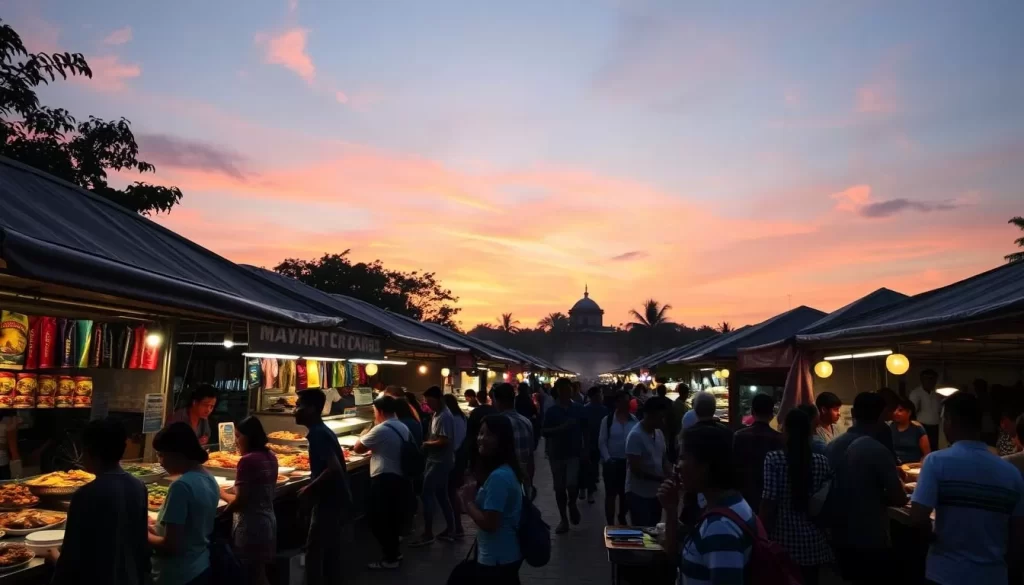
Every evening, the Forodhani Gardens transforms into a vibrant night market, showcasing the rich culinary heritage of Zanzibar. This waterfront park in Stone Town becomes a bustling culinary paradise, with dozens of food stalls setting up to serve fresh seafood, grilled meats, and local specialties under the stars.
Must-Try Street Foods at Forodhani Gardens
The Forodhani Gardens Night Market is the perfect place to sample Zanzibar’s unique street food. You should try the famous Zanzibar pizza, a savory crepe-like pocket filled with meat, cheese, and spices. Other must-try items include sugar cane juice and freshly grilled seafood skewers known as “mishkaki.” The market offers a variety of flavors and dishes that reflect the local culture and cuisine.
The array of street food available is a testament to Zanzibar’s rich culinary diversity. From smoky mishkaki skewers to succulent shawarma and mouth-watering Zanzibari pizza dripping with sauce and eggs, there’s something for every palate. Spices perfume the air as you sample fiery coconut soup and soft, syrup-soaked kokra fritters.
Navigating the Market Like a Local
To navigate the Forodhani Gardens Night Market like a local, start by walking a complete loop to survey all the available options before making your selection. Look for stalls with high turnover, as this indicates freshness. It’s also wise to politely decline persistent vendors until you’re ready to make your purchase. For the best experience, arrive around sunset to watch the market come to life and secure a spot at one of the communal tables where you can dine alongside locals and travelers alike.
While the market is generally safe and food hygiene standards have improved, it’s still important to choose vendors who prepare food fresh in front of you and ensure that seafood is thoroughly cooked. Bringing small bills is also recommended for easier transactions in this cash-only environment.
The Rock Restaurant: Dining on a Coral Outcrop
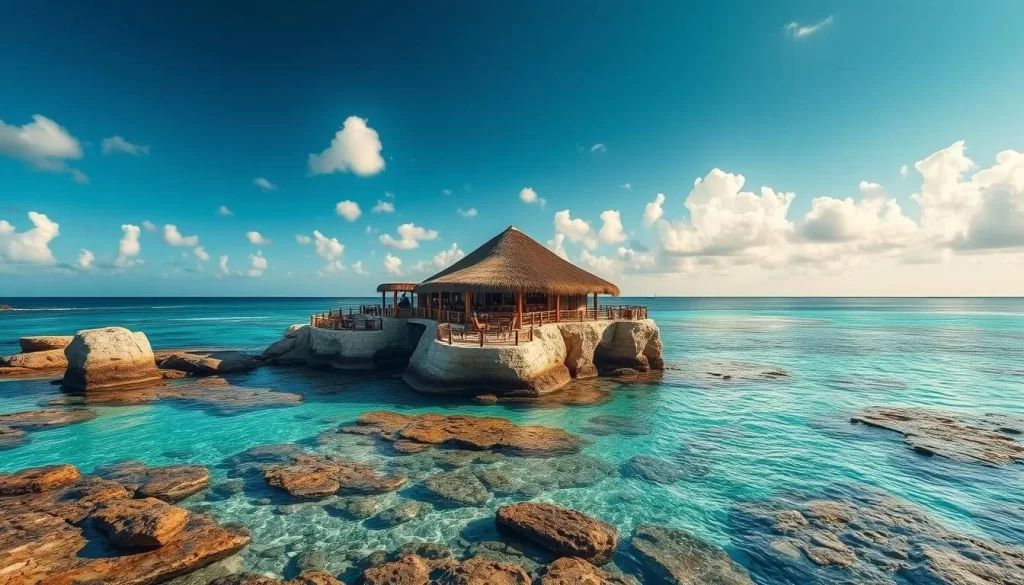
Perched on a coral outcrop in the Indian Ocean, The Rock Restaurant is a dining experience like no other. This iconic restaurant has become a must-visit destination in Zanzibar, offering an unforgettable experience with its unique setting and exquisite seafood.
The Unique Setting and Experience
The Rock Restaurant is located just off Michamvi Pingwe Beach on the island’s eastern coast. What makes this restaurant truly unique is its ever-changing accessibility—during low tide, you can walk right up to it across the exposed seafloor, while high tide transforms it into an island restaurant requiring a short boat transfer. The intimate dining space offers panoramic water views from every table, creating an unforgettable setting where you can watch the changing tides and colors of the Indian Ocean while enjoying your meal.
As you dine, you’ll be surrounded by the soothing sounds of the ocean and the gentle breeze, making for a truly relaxing experience. The restaurant’s unique setting makes it a perfect place to enjoy a romantic dinner or a special occasion.
Menu Highlights and Reservation Tips
The menu at The Rock Restaurant focuses on fresh seafood with Italian influences, featuring signature dishes like The Rock Special, which includes lobster, calamari, king prawns, and catch of the day. You can also indulge in homemade pasta with food that showcases the bounty of Zanzibar’s waters. Reservations are essential, especially for lunch when the views are most spectacular—book weeks in advance during high season, request a window table if possible, and consider a late lunch reservation that allows you to experience both low and high tide during your visit.
To make the most of your visit, plan your time accordingly, taking into account the changing tides. With its unique setting and delicious cuisine, The Rock Restaurant is a truly world-class dining destination that’s a must-visit when in Zanzibar, near the beautiful beach of Michamvi Pingwe.
Water Sports and Activities for Adventure Seekers
With its calm and clear waters, Zanzibar is perfect for a variety of aquatic adventures. The island’s beaches offer a range of water sports and activities that cater to different interests and skill levels.
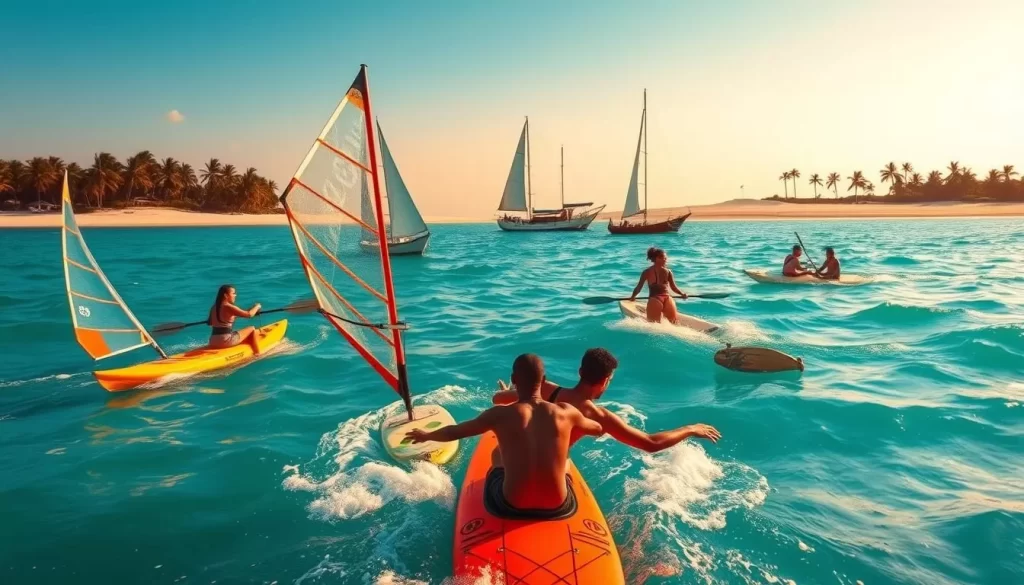
Kitesurfing in Paje: Riding the Indian Ocean Winds
Paje Beach is one of the top destinations for kitesurfing in Zanzibar, thanks to its consistent side-shore winds and wide, sandy beach. The shallow waters provide a safe environment for riders of all skill levels, making it an ideal spot for both beginners and experienced kitesurfers. The combination of reliable winds and expansive shallow lagoon makes Paje Beach perfect for kitesurfing.
Nungwi Beach and Kendwa Beach are also popular spots for kitesurfing, with strong and steady winds, crystal-clear waters, and beautiful sandbars. You can enjoy the thrill of kitesurfing while taking in the breathtaking views of the Indian Ocean.
Transparent Kayaking Around Nungwi and Kendwa
Transparent kayaking is a unique and exciting way to explore Zanzibar’s underwater world. You can rent kayaks and paddle around Nungwi and Kendwa beaches, gliding over coral formations and marine life while staying dry. This activity is perfect for families and those seeking a more relaxed water experience.
Kendwa Beach is one of the best places to watch the sunset over the water, and you can enjoy sundowners at one of the many beach bars around Nungwi-Kendwa after pulling your kayak onto the beach.
Other Thrilling Water Activities
Zanzibar offers a range of other water activities, including stand-up paddleboarding in the calm waters of Matemwe, jet skiing off Nungwi Beach, parasailing for aerial views of the coastline, and traditional dhow sailing trips that combine adventure with cultural heritage. You can choose from a variety of activities that suit your interests and skill level.
- Stand-up paddleboarding in Matemwe’s calm waters
- Jet skiing off Nungwi Beach for an adrenaline rush
- Parasailing for breathtaking views of the coastline
- Traditional dhow sailing trips for a cultural experience
Nakupenda Sandbank: A Slice of Paradise
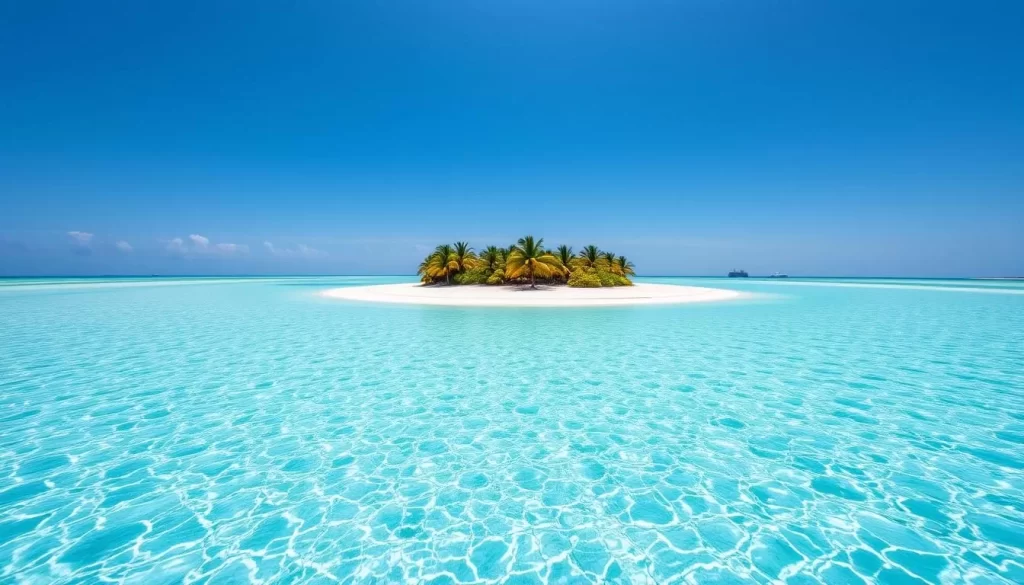
The turquoise waters of Zanzibar hide a treasure – Nakupenda Sandbank, a beautiful sand strip that’s perfect for a day trip. Located between Stone Town and Prison Island, this sandbank appears during low tide, offering a unique natural phenomenon that’s a must-experience in Zanzibar.
The Pristine White Sand Experience
Nakupenda Sandbank, meaning “I love you” in Swahili, is a pristine white sand island that offers a serene escape from the hustle and bustle of Stone Town. As you step onto the sandbank, you’ll be surrounded by crystal-clear waters, perfect for snorkeling and exploring the underwater world. The sandbank experience typically includes relaxing on the immaculate sand, snorkeling in the surrounding waters, and enjoying a freshly prepared seafood barbecue lunch cooked by your boat crew right on the sandbank.
The white sand is powdery and soft, making it a perfect spot to relax and unwind. You can take a leisurely walk along the beach, enjoy the tranquil atmosphere, and soak up the sun. The sandbank is also a great spot for swimming, with the clear waters offering a glimpse into the marine life.
Best Time to Visit and What to Bring
The best time to visit Nakupenda Sandbank is during low tide, and your tour operator will know the optimal timing. Early morning visits offer the most serene experience before other tour boats arrive with the midday crowds. To make the most of your trip, it’s essential to be prepared.
When visiting Nakupenda Sandbank, don’t forget to bring strong sun protection, as there’s no natural shade on the sandbank. You should also wear water shoes to protect your feet from sharp shells and bring snorkeling gear if you have your own. A waterproof bag is also recommended to keep your belongings safe during the boat transfer.
By being prepared and visiting at the right time, you can have a truly unforgettable experience at Nakupenda Sandbank, one of Zanzibar’s most unique beaches.
Cultural Immersion: Village Tours and Local Experiences
Immerse yourself in the authentic culture of Zanzibar by participating in village tours and local experiences. Zanzibar, known as the Spice Island, is not just a destination for beach lovers but also a hub for cultural exploration. The island’s villages offer a glimpse into traditional life, where the rhythms of daily activities are still very much alive.
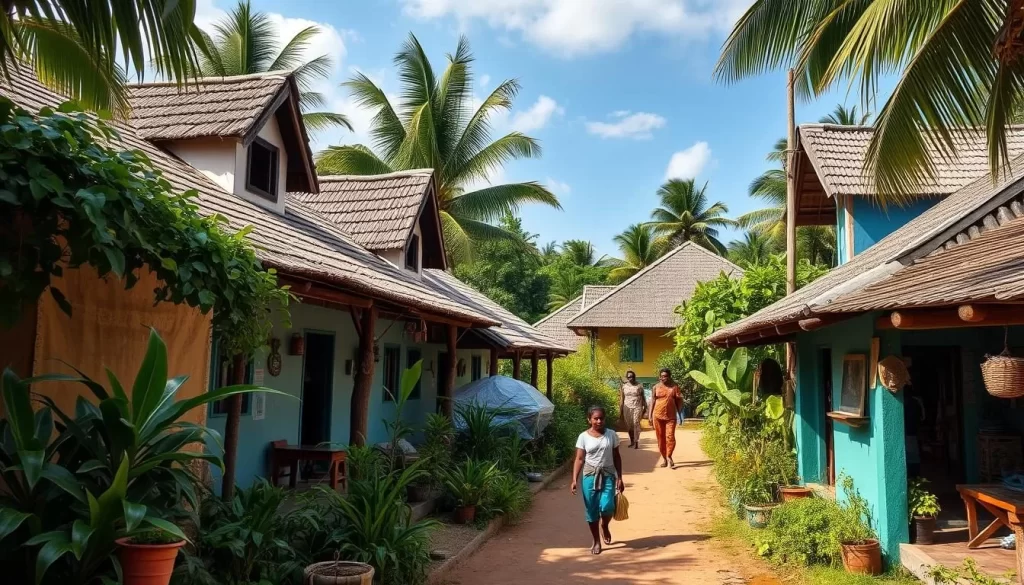
Jambiani Village: Meet the Seaweed Farmers
Jambiani Village on the southeast coast of Zanzibar is a must-visit for anyone looking to experience the island’s unique cultural practices. This female-led village is renowned for its seaweed farming, a practice that has been passed down through generations. Visitors can spend the day with local women, learning about their sustainable seaweed farming practices and even trying their hand at weaving. It’s an empowering experience that showcases the blend of tradition and community spirit.
Traditional Cooking Classes
Zanzibari cuisine is a flavorful reflection of the island’s cultural diversity, influenced by African, Arabian, Indian, and European traditions. Participating in a traditional cooking class is a great way to delve into the local food culture. Classes typically begin with a visit to the local market and spice farm, where you can select the freshest ingredients. Under the guidance of a local chef, you’ll learn to prepare traditional dishes such as pilau rice, octopus curry, and coconut-based sweets. Not only will you learn new culinary skills, but you’ll also get to enjoy the fruits of your labor over a meal.
Authentic Cultural Performances
Zanzibar’s villages are also a stage for authentic cultural performances that reflect the island’s rich heritage. Visitors can enjoy traditional Taarab music, a unique fusion of African, Arabic, and Indian influences, along with energetic Ngoma drumming and acrobatic dance performances. These cultural shows are not just entertaining; they are a window into the stories and traditions that have shaped Zanzibari identity.
Village tours in Zanzibar offer more than just a glimpse into local life; they provide meaningful interactions with the community. When visiting these villages, it’s essential to be respectful of local customs, dress modestly, and ask permission before taking photos. By doing so, you contribute to a positive and enriching experience for both yourself and the local community.
Shopping in Zanzibar: From Spices to Souvenirs
From spices to souvenirs, Zanzibar’s shopping destinations are a reflection of the island’s diverse culture and history. As you explore the island, you’ll discover a treasure trove of unique shopping experiences that showcase the local heritage.
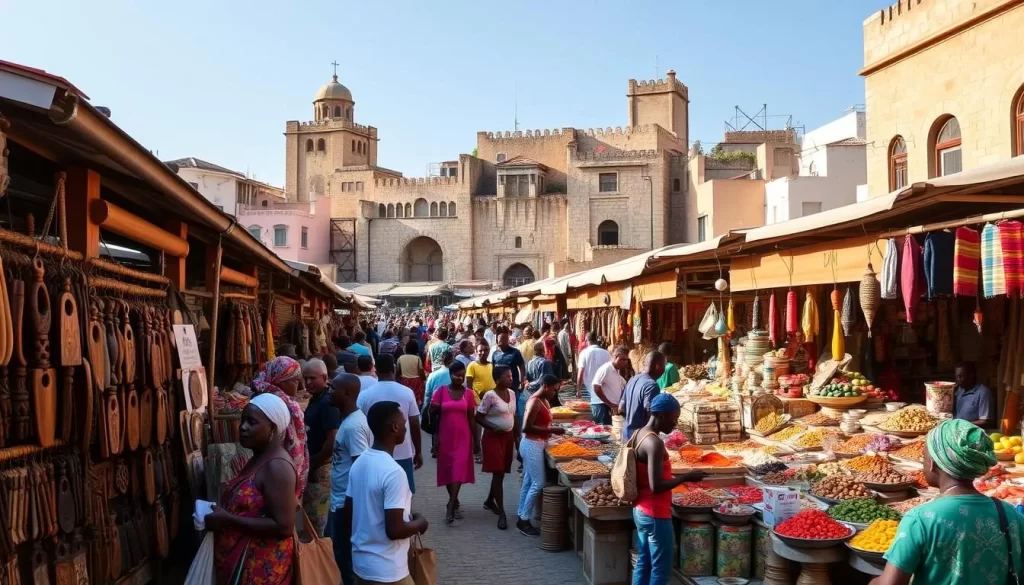
Darajani Market: The Heart of Stone Town Shopping
Darajani Market is the pulse of Stone Town, offering an immersive shopping experience. This aromatic spice market is where you can find a wide variety of spices produced around the islands, including cloves, cinnamon, cardamom, and nutmeg. The market is not just about spices; you can also buy fresh fruit and vegetables, seafood, and handmade crafts and textiles. The Darajani fish market is a must-visit, giving you a real taste of daily life on the islands.
The market represents the commercial heart of Stone Town, where locals shop for daily necessities amid a sensory explosion of colors, sounds, and scents. The famous spice section is particularly noteworthy, with vendors displaying pyramids of spices that are sure to captivate your senses.
Best Souvenirs to Bring Home
Shopping in Zanzibar offers a wide range of unique souvenirs that reflect the island’s rich cultural heritage. Some of the best items to bring home include:
- Freshly packaged spices, especially Zanzibar’s famous cloves and spice mixes
- Handcrafted wooden items with intricate Swahili carvings
- Colorful kangas and kikois (traditional fabrics)
- Miniature Zanzibar doors, perfect for decorative purposes
- Locally grown coffee beans and spice-infused coffee blends
These souvenirs are not only memorable keepsakes but also reflect the island’s cultural identity.
Bargaining Tips and Etiquette
When shopping in Zanzibar’s markets and shops, bargaining is expected and part of the cultural experience. To navigate this effectively, start by offering about half the initial asking price and negotiate with good humor. The goal is to reach a price that feels fair to both parties. By being respectful and open to the process, you can enjoy a positive and enriching shopping experience.
Planning Your Perfect Zanzibar Adventure
Zanzibar, known as the “Spice Island,” offers a mix of relaxation, adventure, and cultural exploration that caters to all kinds of travelers. As you plan your perfect Zanzibar adventure, consider the best time to visit—the dry seasons (June to October and December to February) offer ideal beach weather, while the shoulder seasons provide better rates with still-pleasant conditions.
To make the most of your trip, split your time between at least two areas of the island: explore the cultural attractions of historic Stone Town, and then relax on the beautiful beaches of the north coast or the quieter east or southeast. Zanzibar offers a range of accommodations to suit every travel style and budget, from budget hostels to luxury beach resorts.
Create a balanced itinerary that mixes cultural experiences, beach relaxation, and natural adventures. Schedule at least one spectacular sunset experience at beaches like Kendwa or Michamvi, where the sun dips directly into the ocean, making for an unforgettable trip to this world-renowned destination.
The above is subject to change.
Check back often to TRAVEL.COM for the latest travel tips and deals.
